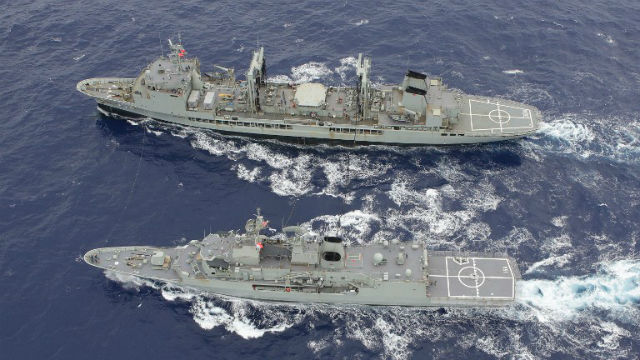SUMMARY
This is AI generated summarization, which may have errors. For context, always refer to the full article.

BEIJING, China – A Chinese ship searching for Malaysia Airlines Flight MH370 detected a “pulse signal” in the southern Indian Ocean on April 5, Saturday, but there was no evidence yet that it was linked to the missing plane, Chinese state media Xinhua said.
The signal picked up by the vessel’s black box detector had a frequency of 37.5kHz*, the official Xinhua news agency said – identical to the beacon signal emitted by flight recorders.
The announcement came nearly a month after the Malaysian jetliner disappeared off radar screens en route from Kuala Lumpur to Beijing with 239 people on board, triggering an unprecedented international search.
Australian and British vessels are currently involved in a round-the-clock underwater search in the southern Indian Ocean, hoping to pick up a signal from the plane’s black box recorder, but the battery powering those emissions is nearing the end of its roughly 30-day life span.
Pulse signal
The Chinese search ship Haixun 01 picked up the pulse signal at about 25 degrees south latitude and 101 degrees east longitude, Xinhua said in a brief dispatch.
“Suspected pulse signal picked up by Haixun 01 has not been identified yet,” the China Maritime Search and Rescue Center said on a verified microblog.
Australian Defence Minister David Johnston said he had not received a report on the signal and warned that it may not be from the plane.
“This is not the first time we have had something that has turned out to be very disappointing,” he told ABC television.
“I’m just going to wait for (JACC chief) Angus (Houston) and the team and my team to come forward with something that’s positive because this is a very very difficult task.”
Slow progress
Up to 10 military planes, three civilian jets and 11 ships are currently involved in the protracted search for the Boeing 777, but have so far failed to find any sign of the plane.
Authorities still have no idea how or why the plane vanished, and warn that unless the black box is found, the mystery may never be solved.
Earlier in Kuala Lumpur, Transport Minister Hishammuddin Hussein said Malaysia would, in line with international agreements, appoint an independent “investigator in charge” to lead an international team to probe what happened to MH370.
The team will include Australia, China, the United States, Britain and France.
Hishammuddin again declined to provide any detail from Malaysia’s ongoing investigation, however, saying he remained focused on finding the plane and its black box.
“In spite of (the long odds), our determination remains undiminished,” he told a press briefing.
Australia is leading the hunt for the plane, which concentrated Saturday on about 217,000 square kilometres of the Indian Ocean some 1,700 kilometres (1,054 miles) northwest of Perth.
Malaysian authorities believe satellite readings indicates MH370 crashed in the Indian Ocean, far off Australia’s western coastline, after veering dramatically off course during a flight from Kuala Lumpur to Beijing.
But no proof has been found that would indicate a crash site, and Australian Prime Minister Tony Abbott has described the oceanic search as “the most difficult in human history”.
The JACC said Australia’s Transport Safety Bureau was continuing “to refine the area where the aircraft entered the water” using further analysis of satellite data and aircraft performance.
Several nations that normally do not work together — notably the United States and China — have rallied to help look for clues in one of the world’s greatest-ever aviation mysteries.
Authorities still have no idea how or why the plane vanished, and warn that unless the black box is found, the mystery may never be solved.
The Ocean Shield, which is carrying a US Navy “black box” detector, and HMS Echo, which has a similar capability, are searching a 240-kilometre track of ocean in hopes of detecting sonic pings from the recorder.
However, progress is painstaking as vessels must move slowly to improve readings, and officials have acknowledge there is no solid evidence the plane went down in that stretch of sea.
“The search using sub-surface equipment needs to be methodical and carefully executed in order to effectively detect the faint signal of the pinger,” Commodore Peter Leavy said. – Rappler.com
*Editor’s Note: In a previous version of this story, we used “kHz per second.” This was based on an AFP story. Our attention was called to the error because “kHz per second” is redundant. kHz or kilohertz already means 1,000 cycles per second or 1,000 hertz. We apologize for the redundancy.
Add a comment
How does this make you feel?
There are no comments yet. Add your comment to start the conversation.